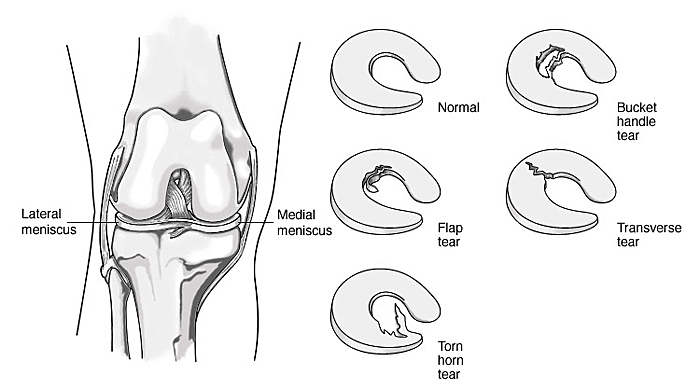Meniscal Damage to the Knee
- One of the most commonly injured parts of a knee, the meniscus, is a wedge-like rubbery cushion where the major bones of a person's leg connect.
- Meniscal cartilage curves like the letter "C" at the inside and outside of each knee.
- Injury can take place to one of the two crescent-shaped cartilage pads between the two joints formed by the femur (the thigh bone) and the tibia (the shin bone).
- Each meniscus acts as a smooth surface for the joint to move on.
- A strong stabilizing tissue, the meniscus helps the knee joint carry weight, glide, and turn in many directions. It also keeps the thighbone and the shinbone from grinding against each other.
- A partial or total tear of a meniscus may occur when a person quickly twists or rotates the upper leg while the foot stays still; for example, when dribbling a basketball around an opponent or turning to hit a tennis ball.
- If the damage is small, the meniscus stays connected to the front and back of the knee; if the tear is large, the meniscus may be left hanging by a thread of cartilage.
- The seriousness of a tear depends on its location and extent.
- Football players and others in contact sports may tear the meniscus by twisting the knee, pivoting, cutting, suddenly stopping, or slowing down too quickly.
- With athletes, meniscal tears often happen in combination with other injuries; such as, a torn ACL (anterior cruciate ligament).
- Severe pain may occur if a fragment of the meniscus catches between the femur and tibia.
- Swelling may occur soon after injury if blood vessels are disrupted, or swelling may occur several hours later if the joint fills with fluid produced by the joint lining (synovium) as a result of inflammation.
- If the synovium is injured, it may become inflamed and produce fluid to protect itself which causes swelling of the knee.
- There are times when an injury that occurred in the past, but was not treated, becomes painful months or years later; especially, if the knee is injured a second time.
- Older people can injure the meniscus without any trauma as the cartilage weakens and wears thin over time, setting the stage for degenerative damage to the knee.
Indications and symptoms
- Someone may experience a "popping" sensation when the meniscus is torn.
- Most people can still walk on the injured knee and many athletes keep playing; however, when symptoms of inflammation set in, the knee usually starts to feel very painful and tight.
- For several days there will be:
- Stiffness and swelling.
- Tenderness in the joint line.
- The collection of fluid ("water on the knee").
- Without treatment, a fragment of the meniscus may loosen and drift into the joint, causing it to slip, pop, or lock causing the knee to "stick", often at a forty-five degree angle, until the knee can manually move or otherwise be manipulated.
- A doctor should be consulted as soon as possible whenever anyone suspects such knee damage.
- Diagnosis may include physical testing to evaluate the extent of the meniscal tear.
- It may be necessary to use X-rays to rule out osteoarthritis or other possible causes of knee pain.
- Sometimes a doctor may use a magnetic resonance imaging scan to get a better look at the soft tissues of the knee joint.
- The doctor may also use a miniature telescope (arthroscope) to see into the knee joint; especially, if the knee locks.

Menisci may be torn in different ways:
- Young athletes often get longitudinal or "bucket handle" tears if the femur and tibia trap the meniscus when the knee turns.
- Less commonly, young athletes get a combination of tears called radial or "parrot beak" in which the meniscus splits in two directions as a result of repetitive stress activities; such as, running.
- In older people, cartilage degeneration that starts at the inner edge causes a horizontal tear as it works its way back.
Non-surgical treatment
- Initial treatment of a meniscal tear follows the basic RICE formula: rest, ice, compression, and elevation, combined with anti-inflammatory medications for pain.
- If the knee is stable and does not lock, this conservative treatment may be all that is needed.
- Blood vessels feed the outer edges of the meniscus, giving that part the potential to heal on its own.
- Small tears on the outer edges often heal themselves with rest.
Surgical repair procedures
- If a meniscal tear does not heal on its own and the knee becomes painful, stiff, or locked; it may need surgical repair.
- Depending on the type of injury, one's age, and other factors; the doctor may use an arthroscope to trim off damaged pieces of cartilage.
- A cast or brace probably will be necessary to immobilize the knee after surgery.
- The patient must complete a course of rehabilitation exercises before gradually resuming any activity.
—Compiled from information located at the
American Academy of Orthopedic Surgeons
and MedicineNet.com; plus checking out other sources.
 You may go to the meniscal, meniscus list of words from here.
You may go to the meniscal, meniscus list of words from here.

